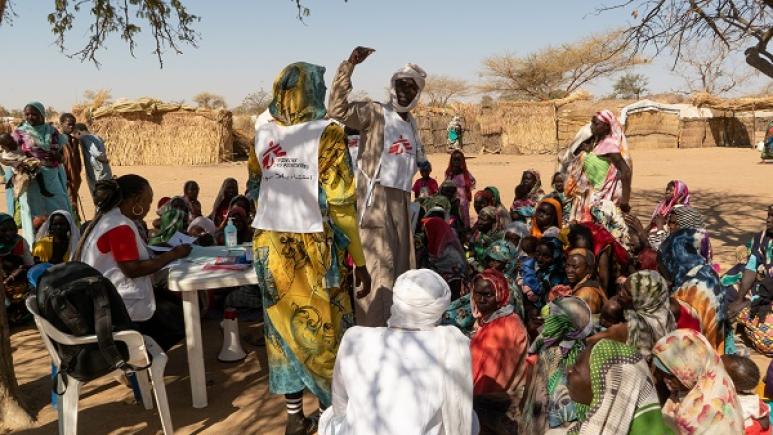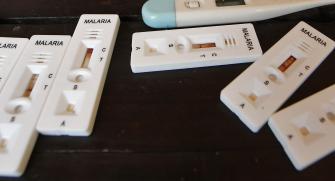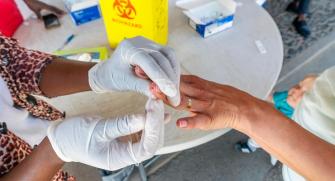10 years of Seasonal Malaria Chemoprevention (SMC) in Moïssala, Chad: Assessment and Prospects
SMC is one of a series of measures designed to prevent malaria, including vector control, intermittent preventive treatment for pregnant women and (in the near future) vaccination. It consists of administering an antimalarial prophylaxis combining sulfadoxine-pyrimethamine and amodiaquine to children aged between 3 and 59 months, every month during the rainy season, when the risk of malaria is high. Since 2012, the World Health Organization (WHO) has recommended its deployment in regions with high seasonal malaria transmission, defined as regions where at least 60% of annual cases occur during a consecutive 4-month period. Since then, it has been adopted and implemented on a large scale in 13 African countries (Benin, Burkina Faso, Cameroon, Chad, Gambia, Ghana, Guinea, Guinea-Bissau, Mali, Niger, Nigeria, Senegal and Togo), reaching more than 45 million children by 2021 (1).
Adapting to the context to optimise SMC
The effectiveness of SMC has been demonstrated in several countries, contributing to the reduction of severe forms of malaria, the prevalence of Plasmodium falciparum, the incidence of uncomplicated clinical malaria and malaria anemia. However, in its 2023 report, the WHO stresses the need for greater flexibility in adapting this strategy to the specific needs of each country, based on more than 10 years' experience of rolling out the SMC (1). It is therefore important to have the appropriate tools to choose the right strategies to implement.
Capitalisation on 10 years of monitoring in Moïssala
Epicentre has carried out several surveys on the coverage of the SMC programme implemented by MSF in collaboration with the Ministry of Public Health and the PNLP in the Moïssala district of Chad since 2013, with a year's interruption in 2019, which has been rich in lessons learned. Over the years, different distribution strategies have been used (number of days, door-to-door, fixed sites) and since 2021, at the request of the PNLP and to take account of the length of the transmission season, the distribution of SMC involves 5 rounds of distribution, instead of the 4 rounds previously carried out. These ten years provide a wealth of information for understanding the impact of these interventions, or lack of them, at Moïssala on the evolution of malaria cases. And to further this understanding, Epicentre epidemiologists have developed a mathematical model that explores the effect of variations in the timing of SMC cycles on the number of malaria cases. According to Jessica Sayyad, epidemiologist at Epicentre, who oversees some of these studies, the first thing to note is that SMC seems to be well accepted by the population, given that the proportion of children whose parents have refused to participate is very marginal.
The second point to highlight is its effectiveness. The increase in cases and hospitalizations in Moïssala in 2019 is due to the absence of SMC that year. Other explanations, such as an increase in the malaria epidemic or a more intense rainy season, cannot be considered. The reintroduction of SMC in 2020 then resulted in a significantly lower incidence than in 2019, but not as low as during the period 2014-2018. Hospital admissions to the malaria unit followed a similar trend.
Jessica Sayyad points out that these studies also provide an opportunity to hypothesize about the improvement of interventions or their effectiveness. The fluctuations between the number of cases and hospitalizations during the distribution of SMC and between cycles seem to indicate that the efficacy fades between cycles, suggesting that the 28-day interval between distributions is perhaps too long or that the drugs used for more than ten years are losing their efficacy. However, both the actual data and the model results support the decision to extend the SMC to 5 cycles. It should also be noted that an increase in rainfall is rapidly followed by an increase in the number of cases. Furthermore, an increase in the number of cases before the SMC period was often observed, as the SMC began too late after the rains. As a result, in 2023, distribution took place from June to October, unlike in previous years when it took place from July to November.
Monitoring resistance
However, the widespread use of antimalarial drugs carries the risk of the emergence of resistant forms of Plasmodium falciparum. One of the characteristics of this parasite is its ability to develop resistance to the drugs used to prevent or treat malaria.
As Francesco Grandesso explains, "research into the genetic mutations in Plasmodium falciparum responsible for resistance to sulphadoxine (the marker known as dhps) and pyrimethamine (the marker known as dhfr) has revealed that resistance to these drugs is not caused by a single genetic mutation, but by the accumulation of several mutations. The more mutations there are, the higher the level of resistance to sulfadoxine-pyrimethamine, and the highest level of resistance is observed in parasites with five mutations (or quintuple mutations): three mutations in the dhfr marker and two in the dhps marker (2-6)."
In 2014, Epicentre began a study of genetic markers of resistance to Moïssala, followed by others in 2021 and 2023. In 2021, the results showed the presence of the triple mutation in dhfr in most parasites (84% of cases), which had already been highlighted in 2014, and documented a clear increase in the quadruple mutation (triple dhfr + dhps437) from 28 to 41% of cases, pointing to a deterioration in the situation. The results for 2023 were therefore eagerly awaited," explains Francesco Grandesso, "and they confirm the upward trend observed previously. Quadruple mutations are present in 48% of samples, and quintuple mutations in 6%, compared with just under 3% in 2021.
Although estimates of markers associated with resistance cannot directly predict treatment failures, their assessments, especially their trends, provide indications as to whether the combination of sulfadoxine-pyrimethamine and amodiaquine remains an effective treatment for SMC. "It now seems crucial to assess resistance more accurately through in vivo studies of therapeutic efficacy", concludes the epidemiologist. A protocol is already being drawn up, and a study is due to start by the end of the year.
Monitoring the efficacy of SMC is of crucial importance at a time when the arrival of new malaria vaccines, RTS,S/AS01 and R21/Matrix-M, is opening up new prospects for controlling the disease. In areas with high seasonal malaria transmission, the R21/MM vaccine has demonstrated a 75% reduction in the number of symptomatic cases in the 12 months following a series of three doses. A fourth dose one year after the third maintains the vaccine's efficacy. This efficacy is comparable to that observed with seasonal administration of RTS,S. (7) In addition, simultaneous administration of the vaccine and SMC further reduces morbidity and mortality. Although the large-scale deployment of these two preventive strategies poses several logistical challenges, it offers real hope in the fight against this parasitic disease.
©Giuseppe La Rosa/MSF
-
https://iris.who.int/bitstream/handle/10665/372840/9789240078475-fre.pdf?sequence=1
-
Plowe CV, Cortese JF, Djimde A, Nwanyanwu OC, Watkins WM, Winstanley PA, et al. Mutations in Plasmodium falciparum dihydrofolate reductase and dihydropteroate synthase and epidemiologic patterns of pyrimethamine-sulfadoxine use and resistance. The Journal of Infectious Diseases. 1997;176:1590–6.
-
Kublin JG, Witzig RS, Shankar AH, Zurita JQ, Gilman RH, Guarda JA, et al. Molecular assays for surveillance of antifolate-resistant malaria. The Lancet. 1998;351:1629–30.
-
Omar SA, Adagu IS, Gump DW, Ndaru NP, Warhurst DC. Plasmodium falciparum in Kenya: high prevalence of drug-resistance-associated polymorphisms in hospital admissions with severe malaria in an epidemic area. Annals of tropical medicine and parasitology. 2001;95:661–9.
-
10. Naidoo I, Roper C. Drug resistance maps to guide intermittent preventive treatment of malaria in African infants. Parasitology. 2011;138:1469–79. 11. Kublin JG, Dzinjalamala FK, Kamwendo DD, Malkin EM, Cortese JF, Martino LM, et al. Molecular
-
markers for failure of sulfadoxine-pyrimethamine and chlorproguanil-dapsone treatment of Plasmodium falciparum malaria. The Journal of Infectious Diseases. Oxford University Press; 2002;185:380–8.
-
https://www.who.int/fr/news/item/02-10-2023-who-recommends-r21-matrix-m-vaccine-for-malaria-prevention-in-updated-advice-on-immunization











